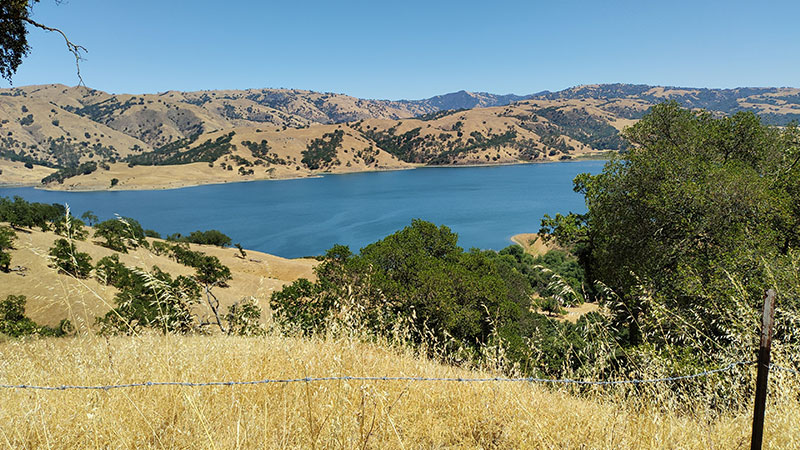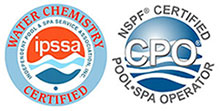Your Pool Uses Less Water Than Your Lawn (And How to Make It Even Better)
Last summer, I sat with a Roseville couple who were nearly in tears. Their water bill had hit $500, and they’d made the heartbreaking decision to remove their pool. “We can’t justify it anymore,” they told me. “Not with the drought and these bills.”
I asked them one question: “How much are you watering your lawn?”
Turns out, they were running their sprinklers 20 minutes every morning. Their beautiful green lawn was consuming about 1,260 gallons per week. Their pool? After we calculated evaporation and occasional top-offs, it was using maybe 200 gallons weekly. Their lawn was literally drinking three times more water than their pool.
They kept the pool. Reduced their lawn watering. Their bill dropped to $280.
I’m Cooper from Pinnacle Pool & Spa Services, and after 10 years helping Northern California pool owners through droughts, water restrictions, and conservation mandates, I can tell you definitively: your pool isn’t the water villain it’s made out to be. In fact, with the right approach, your pool can be one of the most water-efficient features of your property.
The Surprising Truth About Pool Water Usage
Here’s what the actual numbers show, not the perception. A typical 15,000-gallon pool loses about 1/4 inch of water daily to evaporation in summer. That’s roughly 23 gallons. Your lawn? The EPA estimates that the average American household uses 320 gallons of water daily, with 30% going to outdoor use—mostly lawns. In summer, that outdoor percentage can hit 70%.
I’ve been tracking water usage data from my service route for years. Here’s what I’ve found:
Year 1: Yes, filling a pool takes 15,000-20,000 gallons. A lawn the same size (about 500 square feet) uses about 8,000 gallons that first year.
Year 2: Pool uses about 3,000 gallons for top-offs. Lawn uses another 8,000 gallons.
Year 3: Pool still using about 3,000 gallons. Lawn? Still 8,000 gallons.
By year three, your pool has used 21,000 gallons total. Your lawn? 24,000 gallons and counting. After that, the gap just keeps widening.
The Santa Margarita Water District discovered this themselves when they analyzed actual usage. They found pools require thousands of gallons initially but use about 8,000 gallons less water annually than traditional landscaping. The Los Angeles Department of Water and Power came to the same conclusion.
The filling fallacy drives me crazy. People act like you’re filling your pool every year. I have clients with pools that haven’t been drained in 15 years. One filling, properly maintained, lasts decades. Try getting your lawn to survive 15 years on one watering.
“Cooper is very knowledgeable, professional, and honest. He identified the problem as the skimmer, which he promptly replaced and the leak stopped. He was very interested in giving me several options that would fit in my budget.”
— Fran K., San Francisco
Real Conservation That Works (Field-Tested Methods)
Let’s talk about conservation strategies that actually make a difference, not feel-good measures that save a teaspoon while ignoring the gallons.
The Cover Revolution
A quality pool cover reduces evaporation by up to 95%. That’s not marketing hype—that’s measured reality. I had a client in El Dorado Hills losing 50 gallons daily to evaporation. Added a safety cover. Now they lose 3-5 gallons daily. The cover cost $3,000. They save about 12,000 gallons annually. At current water rates, that’s $150-200 per year, plus the reduced chemical costs and heating savings.
Solar covers are even better for daily use. They’re cheaper (about $200-400), reduce evaporation by 70%, and heat your pool for free. The only downside? You have to actually use them. Half my clients who buy solar covers leave them rolled up because they’re “too much hassle.” Fifteen seconds to pull a cover saves hundreds of gallons monthly. Your call.
Leak Detection Saves Thousands
A pinhole leak loses 700 gallons monthly. A moderate leak? Try 6,000 gallons. I’ve seen “small” leaks wasting more water than three households use combined. Yet people ignore that constant wet spot by the equipment or the fact they’re adding water weekly.
Here’s the simple bucket test everyone should do monthly: Place a bucket on your pool step, fill to match pool level, mark both water lines, check in 24 hours. If the pool dropped more than the bucket, you have a leak. It’s that simple, and it could save thousands of gallons.
For comprehensive leak detection methods, check our professional leak detection page. We also have an at-home diagnostics guide for DIY leak checking.
Smart Maintenance Equals Less Waste
Switch from DE or sand filters to cartridge filters. No backwashing needed. That saves 250-500 gallons per backwash, and most people backwash monthly. That’s 3,000-6,000 gallons saved annually.
Proper chemistry means less draining. Balanced water doesn’t need replacement. I have clients who haven’t drained their pools in a decade because they maintain proper chemistry. Meanwhile, their neighbor drains and refills annually because they let their water go bad—wasting 15,000 gallons each time.
The Hidden Water Wasters (It’s Not Your Pool)
Want to know what’s really killing your water bill? It’s usually not your pool.
I do informal water audits when I’m servicing pools. Here’s what I commonly find:
Broken irrigation: A cracked sprinkler head can waste 1,000 gallons daily. I’ve found irrigation lines watering the sidewalk for months. One client in Davis was losing 2,000 gallons daily from a broken line under their lawn. They were ready to drain their pool to save water. The pool wasn’t the problem.
Running toilets: That little trickle can waste 200 gallons daily. Three toilets with minor leaks? That’s 18,000 gallons monthly—more than most pools hold.
The forgotten hose: Leave a hose running and you’ll waste 600 gallons in two hours. I’ve been called to “pool leaks” that turned out to be hoses left on behind shrubs. One client filled their entire pool accidentally when a hose got left on overnight—then blamed the pool for high water usage.
Last month, I helped a Granite Bay family troubleshoot their $400 water bill. Their pool was losing normal evaporation amounts. But their irrigation system was running twice daily instead of twice weekly due to a controller malfunction. Fixed that, bill dropped to $180.
“Cooper goes out of his way to explain options, make recommendations, but does not push unnecessary services or products. He is punctual, returns calls in a timely manner, and I greatly appreciate his honesty, integrity, and work quality.”
— Eric V., Moraga
Emergency Benefits People Forget
During the 2020 California wildfires, pools became heroes. I know of at least five homes in the Auburn area that were saved because firefighters could draft water from pools. One homeowner told me firefighters used his 20,000-gallon pool to protect his entire cul-de-sac.
But here’s the catch—pools are only useful in emergencies if they’re maintained. Algae-filled, chemistry-destroyed water can clog pumps and damage equipment. Los Angeles County Fire specifically notes that well-maintained pools are valuable firefighting resources.
Remember the foreclosure crisis? Thousands of abandoned pools became mosquito breeding grounds. The vector control costs to counties exceeded what any water conservation could have saved. West Nile virus cases spiked in areas with abandoned pools. Maintaining pools isn’t just about recreation—it’s about public health.
Your pool also provides cooling relief during heat waves when public cooling centers are overwhelmed. During last summer’s heat dome, pools literally saved lives by preventing heat stroke. Try getting that from xeriscaping.
My Conservation Action Plan
Here’s your step-by-step guide to making your pool as water-efficient as possible:
Do Today:
- Check for visible leaks around equipment
- Adjust sprinklers so they don’t spray into the pool
- Do the bucket test
- Make sure autofill (if you have one) isn’t stuck on
This Week:
- Get a cover if you don’t have one (solar at minimum)
- Fix any dripping equipment
- Clean your filter (dirty filters require more backwashing)
- Test and balance chemistry to prevent future draining needs
This Month:
- Consider upgrading to a cartridge filter
- Install a hose spigot for controlled draining if needed
- Evaluate your backwash schedule (you’re probably doing it too often)
- Look into pool leak detection if you’re adding water weekly
Seasonal Adjustments:
- Spring: Check winter damage, ensure proper water level
- Summer: Use cover religiously, monitor evaporation
- Fall: Reduce pump time as usage decreases
- Winter: Maintain chemistry to prevent spring drain/refill
“Cooper has always provided great service. He is punctual, returns calls in a timely manner, and I greatly appreciate his honesty, integrity, and work quality. Highly recommended!”
— Eric V., Moraga
Smart Technology for Water Savings
Technology has revolutionized pool water conservation. Here’s what actually works:
Automatic water levelers: Controversial but effective when properly adjusted. They prevent overfilling from forgetting the hose, but can hide leaks. I recommend them with monthly manual checks.
Variable speed pumps: Run longer at lower speeds, reducing splash-out and evaporation from turbulence. Plus they save 70% on energy. Win-win.
Salt systems and ozone: Better sanitization means less draining. Traditional chlorine requires periodic draining to reduce cyanuric acid buildup. Salt and ozone systems can go years longer between drains.
Smart controllers: Monitor water level, chemistry, and temperature remotely. Catch problems before they waste water.
ROI on these investments typically runs 2-4 years from water and energy savings combined. After that, it’s money in your pocket.
Working WITH Water Districts, Not Against Them
Water districts aren’t the enemy. Most have realized pools aren’t the problem. But you need to be a responsible owner to maintain that relationship.
Document your conservation efforts. Keep receipts for covers, leak repairs, and equipment upgrades. Many districts offer rebates for water-saving equipment. Some provide free leak detection dye tablets.
In Northern California, most districts now recognize that maintained pools are water-efficient. Sacramento, Folsom, and Roseville have all walked back initial pool restrictions after analyzing actual usage data. They realized lawns and leaks were the real problems.
Be proactive. If restrictions are announced, contact your district and explain your conservation measures. Show them your covered pool, your leak inspection records, your cartridge filter. Most districts are reasonable when you demonstrate responsibility.
Your Pool is Part of the Solution
After 10 years of drought cycles, conservation mandates, and water worries, I’ve seen pools go from villains to heroes in the conservation story. The data doesn’t lie—properly maintained pools use less water than lawns and provide emergency resources, public health benefits, and mental health value that no amount of artificial turf can match.
One client told me her pool was the only thing that got her family through 2020’s isolation. Another said their pool saved their marriage by giving them a place to relax together after stressful workdays. A grandmother in Folsom credits her pool with keeping her grandkids visiting every summer. Try putting a price on that.
Your pool doesn’t have to be a source of water guilt. With proper maintenance, smart upgrades, and conscious conservation, your pool can be one of the most water-efficient features of your home. You’re not wasting water—you’re storing it in a clean, useful state that serves multiple purposes.
If you want to make your pool as water-efficient as possible, we offer free conservation assessments. We’ll check for leaks, evaluate your equipment, and provide a customized conservation plan. Because keeping pools in California isn’t just about swimming—it’s about responsible ownership in a water-conscious world.
Contact Pinnacle Pool & Spa Services for your free water conservation assessment:
Sacramento Area: (916) 530-2096 | Bay Area: (925) 849-6545 | Toll Free: (888) 994-7665 (POOL)
Professional pool service focused on water conservation and responsible pool ownership throughout Northern California. Helping pool owners save water and money while maintaining their backyard oasis since 2012.



